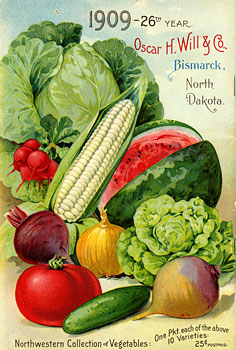
1909 Will Seed Company Catalog back cover
SHSND# 10190The Nehers and Martins supplemented their fruit and vegetable crops with wild fruits. They picked chokecherries, wild plums, Juneberries, buffaloberries, gooseberries, mulberries, ground cherries, and rose hips. Diede recalled that “ordinary families” put up “gallons and gallons of chokecherry jelly.” (Prairie, p. 138) The Nehers are among the very few pioneers who ate “Indian bread root” (Psoralea esculenta). (Prairie, p. 81).
Watermelons were surprisingly popular in water-deprived Dakota gardens. Mary Anne Barnes Williams mentioned Jim Fields, an African American man who homesteaded in McLean County, who was well-known for his gardens, but especially the great quantity of watermelons he raised. (Pioneer Days, vol 2, p. 39.)
Carrie Young wrote about her mother’s gardens in Nothing to Do but Stay. Carrine Gafkjen Berg raised a garden and canned the produce. Though they lived in Williams County and summer heat and sun “parched” the garden, there was “never a year so dry that a potato would not grow.” It was her father’s job to plant and harvest potatoes, but it was Carrine who made sure that when her children boarded in town to attend school, they took plenty of home grown food with them. The two crops that never failed were potatoes and rhubarb which Carrine canned for winter. In “good years” the garden also produced carrots, peas, beets, onions, cucumbers. Beets and cucumbers were pickled and canned. (Nothing, pp. 28, 54, 115) The garden fed not only the family, but threshing crews and holiday and daily visitors including the minister. (Prairie Cooks, p. 16).




